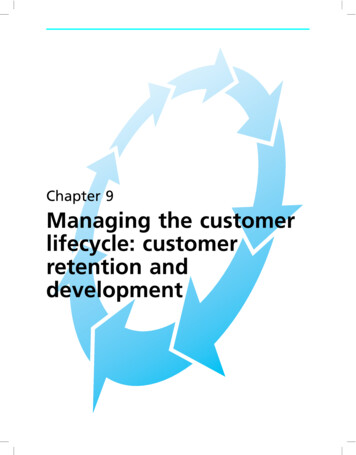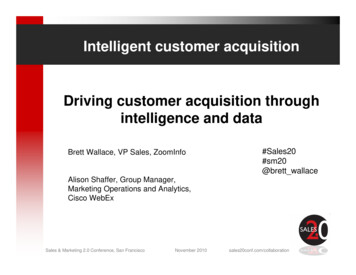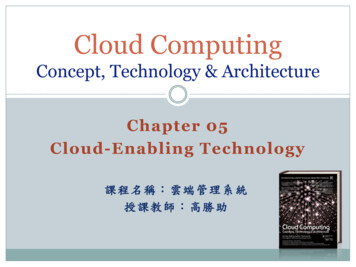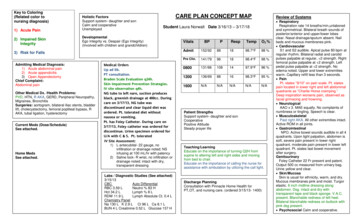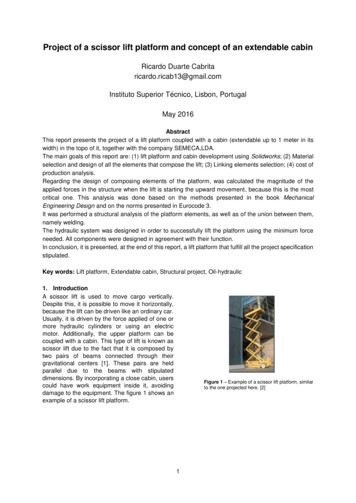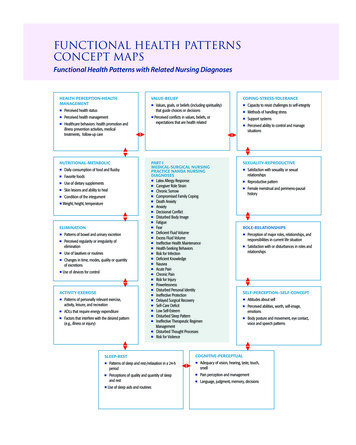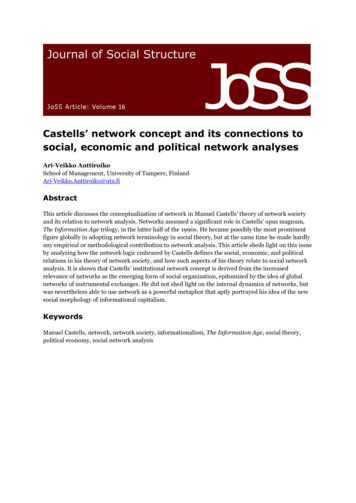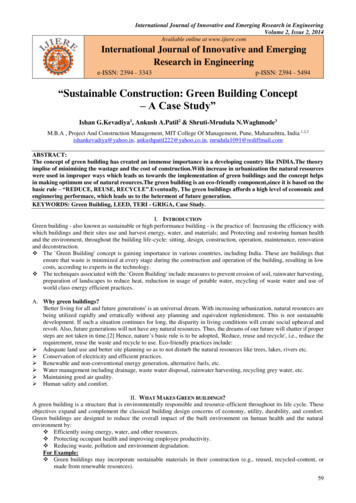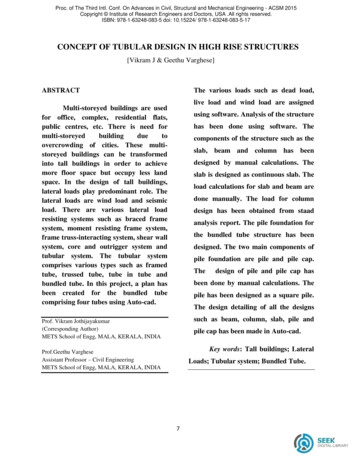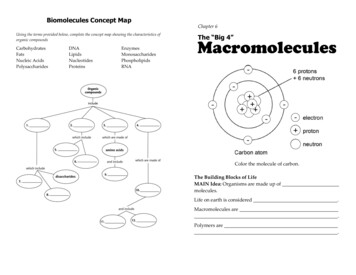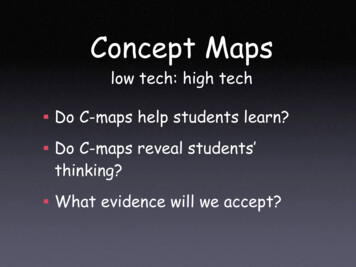
Transcription
Exploring the concept of Customer RelationshipManagement: emphasizing socialJarl Elfving & Karl LemoineMaster thesis, Supervisor: Karin BrunssonDepartment of Business Studies, Uppsala University, 2012-05-25Today the amount of data available is huge and the growth is even vaster. Data containing all sorts of information is easy to acquire and availablefor all who seeks it. The age of Information Technology has produced many potent techniques to collect and compile data; however the nextdecennia may produce technologies that better help us understand how to transform this data into action. This paper seeks to analyze and explainthe importance for firms to use a Customer Relationship Management system that combines all consumer information available. The authors arguethat combining consumer information with increased analytical capabilities could increase the number of decisions based on rationality. Firmsneed to increase internal cooperation between departments, and put an end to departments working as separate units.The purpose of a firm is to create customers. Creatingcustomers can sometimes prove difficult. In acompetitive environment where consumers have severaloptions, this is even more difficult. For firms this meansthat it is of great importance to know which product orservice that will create a customer. Once a customer hasbeen created, firms need to switch part of its focus fromonly customer creation to maintaining and developingstrong ties to already created customers. Hence, in ouropinion, the combination of both creating andmaintaining customers makes a successful firm.In this paper we argue that the trick ofsucceeding in such an endeavor is a CustomerRelationship Management (CRM) system that combinesinformation from all available CRM channels in order toincrease internal synergies and enhance a firm’sanalytical capabilities. Today, data collection software ishighly advanced and automated; software can collect andinterpret both numbers and text. This enables CRMsolutions to capture data from all types of sources withminimal human involvement and at a reasonable cost.Collected data can then be interpreted using softwarewith advanced statistical applications. The data is notonly analyzed from a historical perspective, CRM datacan also involve real-time streams. Real-time streamscan further be explained as; data reaching the analyticalcapabilities of the CRM system with minimal delay, bymaking this process as efficient as possible, this delaycould be as short as micro-seconds. This enables thesystem to learn and adjust the outcome of the analysis, asnew information is included. In order for this system toproduce a usable output for businesses selling directly toconsumers (B2C), the system needs as many sources aspossible to collect data about consumers. One datasource that for the last couple of years rapidly increasedin generating data is social media. Hence, includingsocial media as a CRM channel would increase the CRMsystem amount of data, especially when collecting dataabout consumers in the younger ages.A study by Statistics Sweden (SCB, 2011)found that 95 percent of males and 93 percent of femalesin the ages 16 to 24 have used social media such asFacebook and Twitter. Another social media study byHutton and Fosdick (2011) shows that people creating asocial network profile increased from 27 percent to 74percent within the period 2006-2010. Social networkingcould therefore be argued to be a global movement(Hutton & Fosdick, 2011). Social media have a broaddefinition and can include channels such as socialnetworks like Twitter and Facebook, but also other typesof media like blogs, and forums. Data regarding all typesof sectors can easily be found in social channels and theamount of data is rapidly increasing. According toBollier (2010) and The Economist (2010) big data couldprovide firms with more extensive information abouttheir consumers. The dominance of the digital economyhas made the amount of consumer information dataincreasingly important for decision-makers (Frolick &Ariyachandra, 2006). Davenport & Harris (2007) andAhmad & Quadri (2012) stress the importance for firmsto analytically understand this huge amount of data, takeaction and decisions. Explanatory models, predictivemodels, statistics, and quantitative analysis are theelements of firm’s decision-making. Information fromsocial channels include information that consumersthemselves provide, Bedell (2011) argues that data fromthese channels might need to be included in traditionaldecision-support tools. This might lead to improvedfinancial performance across entire businesses,streamlined operations and enhanced customersatisfaction.In order for B2C to gain insight into customerbehavior, they need to have the capacity to capture andanalyze critical customer data in terms of customers’needs as well customers’ willingness to interact with thecompany (Freeland, 2003). Arnold (2009) argues thatreal-time intelligence is a concept, which should includedata from social media. Real-time intelligence is possiblesince the data from social media can be collected byautomatic processes.Internet has provided firms with a uniqueopportunity to get closer to customers, these dayscustomers turn to the web first for practically anything(Beyer, 2011).1
“Jumping into the center of the pond andclosely studying the dynamics of the ecosystem.Surrounded by so many organisms and so much activity,you’re certain to figure out where in the pond the mostfish reside, what they’re hungry for, etc.” (Crosley, 2011p.40)We argue that Crosley (2011) is correct in hisreasoning about the opportunities that are available forfirms to get closer to customers. However, we do notbelieve that the quote above aims to describe a situationwhere it is a matter of firms not wanting to jump into“the center of the pond” with customers. It is rather thecustomers that have switched pond and firms need toswitch as well.The aim of this paper is to study how firmstoday use CRM as a concept. The purpose of the paperis: 1) to analyze if and how traditional CRM channelsand social channels can be combined. 2) to analyze thepotential benefits of such an endeavor.The structure of the literature review is asfollows: first we present the CRM concept. Then wepresent the social aspect of CRM. The CRM concept isthen widened to include the social aspect; hence wedevelop our own definition of a modern customerrelationship management concept (MCRM).The aspects of commitment and innovation bothbenefit with increased customer insight. Increasedcustomer insight is also something that we see as anoutput of MCRM. Hence, the aspect of creatingcommitment and innovation are further elaborated in theliterature review. In this paper, problems with increasedbusiness insight are described as the analyzing process ofbig data sets. Therefore, the literature review also has ananalytical perspective. This analytical perspectivefocuses on problems and possibilities with large data sets.The end of the literature review describes the technicalaspect of handling big data. The technical perspectivewas included to educate a reader without a technicalbackground about how data physically are collected,analyzed, and made actionable.The concept of Customer RelationshipManagementThe concept of Consumer Relationship Management(CRM) does not have a clear definition; rather Payne &Frow (2005) state that there is a lack of a consensus onthe definition of CRM. Foss et al. (2008) provides twoguidelines of the CRM concept. First, a CRM conceptthat is too narrow-based often contributes to the failureof CRM projects. Second, a contributing factor to thefailure of CRM projects is when an firm views CRMfrom a limited technology perspective or undertakesCRM in a fragmented way. A CRM system is a firm toolthat is technology-based for developing and leveragingconsumer knowledge to nurture, maintain, andstrengthen profitable relationships with consumers.Therefore according to Buttle (2001), a CRM system is acrucial part of a global CRM strategy, in where theshareholder value through the development ofappropriate relationship with key consumers andconsumer segments is of utmost importance.According to Foss et al., (2008) CRM can bedivided into two parts, operational and analytical. Theoperational CRM perspective is about trainingemployees, especially the sales force, in how to deal withconsumers. A firms operates with this training to controlthe interaction it has with its consumers, this involvessales force automation, marketing, and consumer service.This is done in order to make these functions moreefficient and effective e.g. CRM system might guide asalesperson through identification of consumer-relatedinformation when making a sales call. The informationcan immediately be connected to back offices ortransferred to other functional departments and otherchannels of communication in order to identify andprovide the consumer with a valuable market offering.Analytical CRM involves the technologies that aggregateconsumer information and provide analysis of theconsumer data to enhance managerial decision-makingand actions. Analytical CRM is based on technologiessuch as data warehousing and data mining. In a perfectworld, the database should be accessible from all therelevant departments e.g. consumer service, sales, andmarketing. This type of CRM forms the foundation forplanning and evaluation of marketing campaigns andassists cross-selling and up-selling functions. In order tosuccessfully implement CRM, organizations mustcombine physical resources, e.g. computers sources, e.g. consumer databases, salespeople’s zational resources, e.g. consumers oriented culture,information sharing routines. According to Hunt &Lambe (2000) a successful CRM implementation iswhen a CRM system helps a company profitably delivermarket offering to consumers that: provide value toconsumers if possible to a lower cost than thecompetition, provide more value at the same relative costrelative to the competition, provide more value at alower cost than the competition.Adding Social MediaRelationship ManagementtoConsumerThe concept of CRM described by Foss et al., (2008)discusses consumer channels such as sales forceautomation, marketing, and consumer support. Thesechannels have traditionally been consisting ofinformation that has flown directly between firms andconsumers. Hence, firms have historically had a strictgrip over this relationship. Today, a new channel ofinformation is growing; this channel is generally calledsocial media. The difference between social media andthe traditional CRM channels is that it cannot becontrolled by firms. Consumers are no longer solelycommunicating directly to firms; the trend is thatconsumers are interacting with each other in terms ofexpressing their opinions, ideas, thoughts, experiences,confidences and jokes on social media. Through socialmedia, consumers are able to reach a big audience with2
relatively low costs; therefore it is argued that the powerand influence of consumers are increasing (Pavicic et al.,2011). If firms manage this channel correctly, it givesthem a huge opportunity to get insight in consumers’wants and needs since consumers tend to express theirwants and needs on a deeper level through social mediachannels than on traditional CRM channels (Heller Baird& Parasnis 2011; Woodcook et al., 2011). The aspect ofmanaging customer relationships by means of socialmedia channels, Social Customer RelationshipManagement (SCRM) can further be explained as firmsengaging consumers; when there is a consumer need,wherever the consumer is, in a way that is convenient forthe consumer. Woodcook et al., (2011) argue that byengaging consumers through a social media channels,firms can provide consumers with personal experiencewhich is crucial in order to keep them interested,informed, engaged and maybe even entertained. Overtime, firms learn to tailor solutions to individualconsumer needs. However, a social media channelcannot replace traditional CRM channels, but it cancontribute to increased business insight. Combining atraditional CRM channel, e.g., a consumer loyalty clubwith a social CRM channel e.g. mobile phonescontaining GPS services, enables firms to offer a specificdeal to a consumer. This deal would be based on earlierpurchasing behavior and the location of the consumer atthat specific moment. Further, a CRM system containingthe social media channel could increase a “personaltouch” in the B2C relationship since the social mediachannel contains information about consumer’s feelings,thoughts, opinions etc. on a more personal level thantraditional CRM channels (Woodcook et al., 2011).Developing Modern Customer RelationshipManagement and creating commitmentAdding Social CRM to the CRM concept should be thefoundation of a modern CRM concept (MCRM). In aMCRM concept it would be an increase in the amount ofdata being collected; hence, it will require that firmshave automated processes in order to handle increasedamounts of data. Automated processes will give benefitsboth in operational perspective of MCRM and in theanalytical perspective of MCRM. The operationalperspective will benefit in terms of economies of scalefrom combining e.g. customer support from bothtraditional CRM channels and social CRM channels. Theanalytical perspective will benefit from a morecomprehensive picture of consumers. MCRM might,therefore, increase business insight and increase firms’response time to understand consumer behavior. It mayalso minimize ad hoc decision making, since theanalytical part of MCRM produces actual figures that arebased on data from both social media channels andtraditional CRM channels. A reasonable assumption isthat by having a deeper understanding of consumerbehavior, firms should be able to increase consumercommitment. Consumer commitment has been sh
with advanced statistical applications. The data is not only analyzed from a historical perspective, CRM data can also involve real-time streams. Real-time streams can further be explained as; data reaching the analytical capabilities of the CRM system with minimal delay, by making this process as efficient as possible, this delay could be as short as micro-seconds. This enables the system to .
